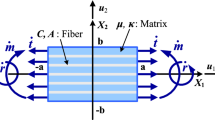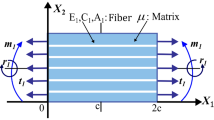Abstract
A third-gradient continuum model is developed for the deformation analysis of an elastic solid, reinforced with fibers resistant to flexure. This is framed in the second strain gradient elasticity theory within which the kinematics of fibers are formulated, and subsequently integrated into the models of deformations. By means of variational principles and iterated integrations by parts, the Euler equilibrium equation is obtained which, together with the constraints of bulk incompressibility, compose the system of the coupled nonlinear partial differential equations. In particular, a rigorous derivation of the admissible boundary conditions arising in the third gradient of virtual displacement is presented from which the expressions of the triple forces are derived. The resulting triple forces are, in turn, coupled with the Piola-type triple stress and are necessary to determine a unique deformation map. The proposed model predicts smooth and dilatational shear angle distributions, as opposed to those obtained from the first- and second-gradient theory where the resulting shear zones are either non-dilatational or non-smooth.












Similar content being viewed by others
References
Voigt, W.: Theoretical studies in the elastic behavior of crystals. Abh. Gesch. Wiss. 34, 1 (1887)
Monecke, J.: Microstructure dependence of material properties of composites. Phys. Status Soldi. (b) 154, 805–813 (1989)
Hahm, S.W., Khang, D.Y.: Crystallization and microstructure-dependent elastic moduli of ferroelectric P(VDF-TrFE) thin films. Soft Matter 6, 5802–5806 (2010)
Moravec, F., Holecek, M.: Microstructure-dependent nonlinear viscoelasticity due to extracellular flow within cellular structures. Int. J. Solids Struct. 47, 1876–1887 (2010)
Boutin, C.: Microstructural effects in elastic composites. Int. J. Solids Struct. 33(7), 1023–1051 (1996)
Forest, S.: Homogenization methods and the mechanics of generalised continua part 2. Theor. Appl. Mech. 28, 113–143 (2002)
Mulhern, J.F., Rogers, T.G., Spencer, A.J.M.: A continuum theory of a plastic–elastic fibre-reinforced material. Int. J. Eng. Sci. 7, 129–152 (1969)
Spencer, A.J.M.: Deformations of Fibre-Reinforced Materials. Oxford University Press, Oxford (1972)
Pipkin, A.C., Rogers, T.G.: Plane deformations of incompressible fiber-reinforced materials. ASME J. Appl. Mech. 38(8), 634–640 (1971)
Toupin, R.A.: Theories of elasticity with couple stress. Arch. Ration. Mech. Anal. 17, 85–112 (1964)
Mindlin, R.D., Tiersten, H.F.: Effects of couple-stresses in linear elasticity. Arch. Ration. Mech. Anal. 11, 415–448 (1962)
Koiter, W.T.: Couple-stresses in the theory of elasticity. Proc. K. Ned. Akad. Wetensc. B 67, 17–44 (1964)
Park, H.C., Lakes, R.S.: Torsion of a micropolar elastic prism of square cross section. Int. J. Solids Struct. 23, 485–503 (1987)
Maugin, G.A., Metrikine, A.V. (eds.): Mechanics of Generalized Continua: One Hundred Years After the Cosserats. Springer, New York (2010)
Munch, I., Neff, P., Wagner, W.: Transversely isotropic material: nonlinear Cosserat vs. classical approach. Contin. Mech. Therm. 23, 27–34 (2011)
Neff, P.: A finite-strain elastic-plastic Cosserat theory for polycrystals with grain rotations. Int. J. Eng. Sci. 44, 574–594 (2006)
Neff, P.: Existence of minimizers for a finite-strain micro-morphic elastic solid. Pro. R. Soc. Edinb. A 136, 997–1012 (2006)
Park, S.K., Gao, X.L.: Variational formulation of a modified couple-stress theory and its application to a simple shear problem. Z. Angew. Math. Phys. 59, 904–917 (2008)
Fried, E., Gurtin, M.E.: Gradient nanoscale polycrystalline elasticity: intergrain interactions and triple-junction conditions. J. Mech. Phys. Solids 57, 1749–1779 (2009)
Spencer, A.J.M., Soldatos, K.P.: Finite deformations of fibre-reinforced elastic solids with fibre bending stiffness. Int. J. Non-Linear Mech. 42, 355–368 (2007)
Steigmann, D.J.: Theory of elastic solids reinforced with fibers resistant to extension, flexure and twist. Int. J. Non-Linear Mech. 47, 743–742 (2012)
dell’Isola, F., Giorgio, I., Pawlikowski, M., Rizzi, N.L.: Large deformations of planar extensible beams and pantographic lattices: heuristic homogenization, experimental and numerical examples of equilibrium. Proc. R. Soc. Lond. A 472(2185), 20150790 (2016)
dell’Isola, F., Della Corte, A., Greco, L., Luongo, A.: Plane bias extension test for a continuum with two inextensible families of fibers: a variational treatment with Lagrange multipliers and a perturbation solution. Int. J. Solids Struct. 81, 1–12 (2016). https://doi.org/10.1016/j.ijsolstr.2015.08.029
dell’Isola, F., Cuomo, M., Greco, L., Della Corte, A.: Bias extension test for pantographic sheets: numerical simulations based on second gradient shear energies. J. Eng. Math. 103(1), 127–157 (2017). https://doi.org/10.1007/s10665-016-9865-7
Zeidi, M., Kim, C.: Mechanics of an elastic solid reinforced with bidirectional fiber in finite plane elastostatics: complete analysis. Contin. Mech. Thermodyn. 30(3), 573–592 (2018)
Zeidi, M., Kim, C.: Mechanics of fiber composites with fibers resistant to extension and flexure. Math. Mech. Solids. 24(1), 3–17 (2017)
Kim, C., Zeidi, M.: Gradient elasticity theory for fiber composites with fibers resistant to extension and flexure. Int. J. Eng. Sci. 131, 80–99 (2018)
Javili, A., dell’Isola, F., Steinmann, P.: Geometrically nonlinear higher-gradient elasticity with energetic boundaries. J. Mech. Phys. Solids 61(12), 2381–2401 (2013)
dell’Isola, F., Seppecher, P., Madeo, A.: How contact interactions may depend on the shape of Cauchy cuts in Nth gradient continua: approach à la D’Alembert. Z. Angew. Math. Phys. 63, 1119–1141 (2012). https://doi.org/10.1007/s00033-012-0197-9
dell’Isola, F., Corte, A.D., Giorgio, I.: Higher-gradient continua: the legacy of Piola, Mindlin, Sedov and Toupin and some future research perspectives. Math. Mech. Solids 22(4), 852–872 (2016)
Landau, L.D., Lifshitz, E.M.: Theory of Elasticity, 3rd edn. Pergamon, Oxford (1986)
Dill, E.H.: Kirchhoff’s theory of rods. Arch. Hist. Exact Sci. 44, 1–23 (1992)
Antman, S.S.: Nonlinear Problems of Elasticity. Springer, Berlin (2005)
Germain, P.: The method of virtual power in continuum mechanics, part 2: microstructure. SIAM J. Appl. Math. 25, 556–575 (1973)
Dell’Isola, F., Seppecher, P.: The relationship between edge contact forces, double forces and interstitial working allowed by the principle of virtual power. C. R. Acad. Sci. IIb. Mec. Elsevier, pp. 7 (1995)
Abali, B.E., Muller, W.H., dell’Isola, F.: Theory and computation of higher gradient elasticity theories based on action principles. Arch. Appl. Mech. 87(9), 1495–1510 (2017)
Zeidi, M., Kim, C.I.: Finite plane deformations of elastic solids reinforced with fibers resistant to flexure: complete solution. Arch. Appl. Mech. 88(5), 819–835 (2018)
Truesdell, C., Noll, W.: The non-linear field theories of mechanics. In: Flugge, S. (ed.) Handbuch der Physik, vol. III/3. Springer, Berlin (1965)
Reissner, E.: A further note on finite-strain force and moment stress elasticity. Z. Angew. Math. Phys. 38, 665–673 (1987)
Pietraszkiewicz, W., Eremeyev, V.A.: On natural strain measures of the non-linear micropolar continuum. Int. J. Solids Struct. 46, 774–787 (2009)
dell’Isola, F., Steigmann, D.J.: A Two-dimensional gradient-elasticity theory for woven fabrics. J. Elast. 118(1), 113–125 (2015). https://doi.org/10.1007/s00419-018-1344-3
Askes, H., Suiker, A., Sluys, L.: A classification of higher-order strain-gradient models—linear analysis. Arch. Appl. Mech. 72, 171–188 (2002). https://doi.org/10.1007/s00419-002-0202-4
Alibert, J.J., Seppecher, P., Dell’Isola, F.: Truss modular beams with deformation energy depending on higher displacement gradients. Math. Mech. Solids 8(1), 51–73 (2003)
Steigmann, D.J.: Finite Elasticity Theory. Oxford University Press, Oxford (2017)
Ogden, R.W.: Non-linear Elastic Deformations. Ellis Horwood Ltd., Chichester (1984)
Acknowledgements
This work was supported by the Natural Sciences and Engineering Research Council of Canada via Grant #RGPIN 04742 and the University of Alberta through a start-up grant. Kim would like to thank Dr. David Steigmann for stimulating his interest in this subject and for his continual support and encouragement.
Author information
Authors and Affiliations
Corresponding author
Additional information
Communicated by Andreas Öchsner.
Publisher's Note
Springer Nature remains neutral with regard to jurisdictional claims in published maps and institutional affiliations.
Appendix: Finite element analysis of the fourth-order coupled PDE
Appendix: Finite element analysis of the fourth-order coupled PDE
The resulting systems of PDEs (Eqs. (50)–(51)) are sixth-order differential equations with coupled nonlinear terms. The case of such less regular PDEs deserves delicate mathematical treatment as done similarly in [25, 37] and is of particular practical interest. Therefore, it is not trivial to demonstrate numerical analysis procedures regarding FE analysis.
For preprocessing, Eqs. (50)–(51) may be recast as
where \(Q=\chi _{1,11}\), \(R=\chi _{2,11}\), \(S=Q_{,11}\) and \(T=R_{,11}\). Thus, we reduced the order of deferential equations from three coupled equations of sixth order to eight coupled equations of second order. In particular, the nonlinear terms (e.g., \(A\chi _{2,2}\), \(B\chi _{2,1}\), etc.) in the above equations can be systematically treated via the Picard iterative procedure;
where the values of A and B continue to be updated based on their previous estimations (e.g., \(A_{1}\) and \(B_{1}\) are refreshed by their previous pair of \(A_{0}\) and \(B_{0})\) as iteration progresses. Hence, we generalize the above expression for N number of iterations as
in which the number of iteration can be determined by a convergence criteria.
In addition, the weighted forms of Eq. (76) are obtained by
Applying integration by parts and Green–Stoke’s theorem (e.g., \(\mu \int _{\Omega ^{e}}w_{1}\chi _{1,22}d\Omega =-\mu \int _{\Omega ^{e}}w_{1,2}\chi _{1,2}d\Omega +\mu \int _{\Omega ^{e}}w_{1}\chi _{1,2}Nd\Gamma \)), we obtain from the above that
where \(\Omega \), \(\partial \Gamma \) and \(\mathbf {N}\) are the domain of interest, the associated boundary, and the rightward unit normal to the boundary \(\partial \Gamma \) in the sense of the Green–Stoke’s theorem, respectively. The unknowns, \(\chi _{1}\), \(\chi _{2}\), Q, R, S, T, A and B can be written in the form of Lagrangian polynomial as
Thus, the test function w is obtained by
Here, \(w_{i}\) is weight of the test function and \(\Psi _{i}(x,y)\) are the shape functions for the four-node rectangular elements such that
By means of Eq. (81), Eq. (80) can be rewritten in terms of Lagrangian polynomial representation as
Now, for the local stiffness matrices and forcing vectors for each elements, we find
or alternatively, in a compact form,
where
and
Accordingly, the unknowns (i.e., Q, R, S, T, A and B) can be expressed as
Finally, we repeat the same procedures for the rest of components (e.g., \(\left[ K_{ij}^{21}\right] [\chi _{2}^{i}]=[F_{i}^{2}]\), etc.) and thereby obtain the following systems of equations (in the Global form) for each individual elements.
In the simulation, the following convergence criteria are used for both nonlinear terms;
which demonstrate fast convergence within 20 iterations (see Table 2).
Rights and permissions
About this article
Cite this article
Kim, C.I., Islam, S. Mechanics of third-gradient continua reinforced with fibers resistant to flexure in finite plane elastostatics. Continuum Mech. Thermodyn. 32, 1595–1617 (2020). https://doi.org/10.1007/s00161-020-00867-3
Received:
Accepted:
Published:
Issue Date:
DOI: https://doi.org/10.1007/s00161-020-00867-3




